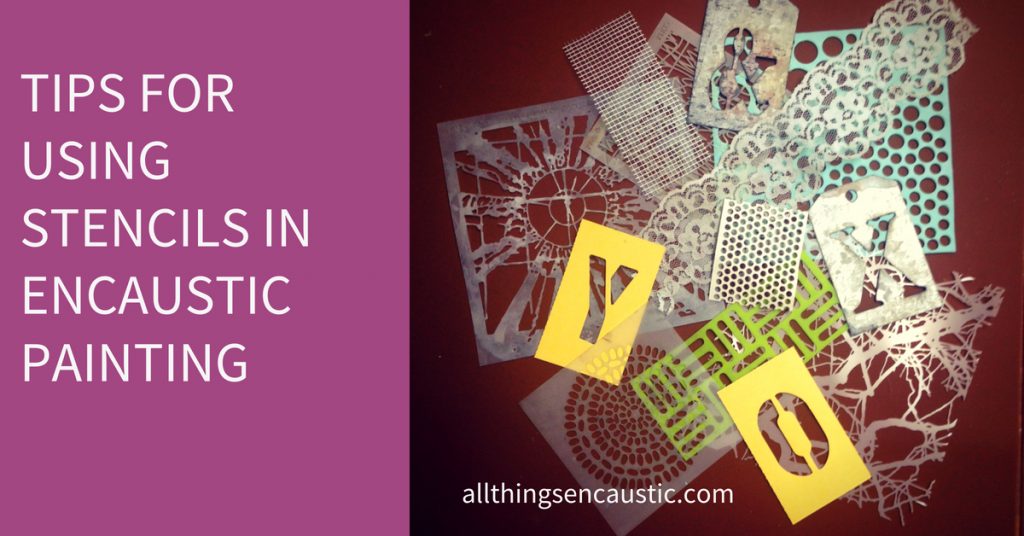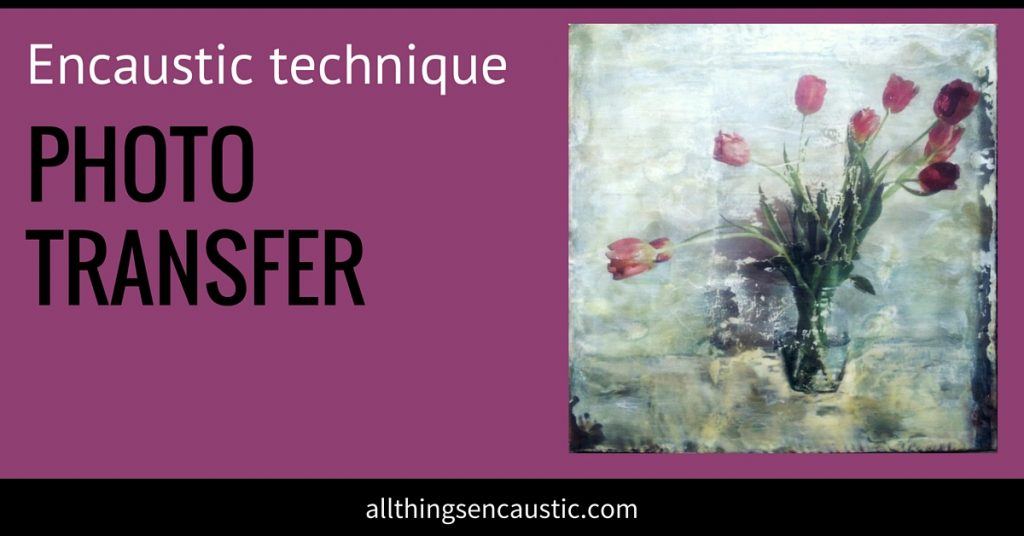Sourcing Stencils for Encaustic Painting
When using stencils in encaustic art it is important to create or purchase stencils that work well with heat. If you don’t use a heat-resistant stencil, your stencil will melt!
Artist Lynda Ray sells heat tolerant silicone encaustic stencils from her Etsy shop. Her fabulous stencils are designed specifically for encaustic painting. Silicone is ideal for partnering with wax!
If you’re looking to purchase pre-cut stencils, StencilGirl stencils are made of heat-resistant mylar so they work well with hot wax.
You can also cut your own stencils for encaustic from heat-resistant Dura-lar or from cardstock paper using an X-Acto knife or a stencil cutting machine.
Found materials such as lace or drywall tape can also work as a stencil. Just make sure that whatever you choose can handle the heat.
How to use a stencil with encaustic medium in 7 steps
- Position the stencil on top of your encaustic painting, it’s best to choose a smooth area.
- Apply a first thin layer of clear encaustic medium with a brush through the stencil and fuse with the iron. This layer will ensure that if there is any bleed-through it is clear.
- Apply a thin layer of coloured medium with a brush.
- Fuse with the iron. The iron is the fusing tool of choice when using stencils in encaustic painting. The iron will push the wax down into the stencil creating a flat surface.
- Let the wax cool (but not get cold) then take a flat metal scraper and drag it across the surface – this helps you get a crisp clean line.
- As you peel off the stencil, hold down the edges of the wax. Gently remove the stencil, lace or tape before the wax becomes totally cold, you don’t want it to become a collage element!
- If any wax has bled through under the stencil, you can use a scraper tool to clean up the edge. If it isn’t perfect relax, a deconstructed look can be awesome.
Cleaning wax off of your stencils
As long as you are using heat-tolerant stencils, cleanup is easy. Place the stencil between two paper towels and iron it with your encaustic iron. The paper towels will absorb the wax and you can reuse your stencil over and over again. The cooled hard wax will peel off of silicone stencils very easily. Use soap and water to remove any ink or pigment residue.
Additional ways to use stencils on an encaustic painting
You can also place a stencil on your painting and, instead of encaustic medium, you can apply pan pastels through the stencil onto warm wax. Remove the stencil and gently fuse with a heat gun.
Another way to use a stencil is to lay it on washi paper, tissue paper, or a page from an old book, then spritz the paper with walnut ink. When the ink has dried you can add the paper as a collage element to your painting.
Craft stores carry metal stencils. A fun way to use a metal stencil is to place it on the wood substrate before you begin to paint and turn the blowtorch on it to burn the pattern into the surface. Be sure that you don’t touch the scorching-hot metal stencil with your hands until it has cooled down completely!
You can use the same stencil pattern repeatedly on multiple layers of wax to add depth to your painting.
If you like using stencils with encaustic, you may also want to explore using impression mats with encaustic painting.
Are there other ways that you’ve used stencils in your encaustic art? Please add a comment below.
- Encaustic Underpainting using a Stay-Wet Palette - February 13, 2024
- Cardboard as a Substrate for Encaustic Painting - November 20, 2023
- Create Three-Dimensional Structures With Fosshape - April 2, 2023
- How to reuse encaustic scrapings - February 2, 2023
- Christina Lovisa’s Homemade Paste for Collage - December 12, 2022
- Glass As A Substrate For Encaustic Painting! - November 8, 2022
- How to organize your art studio - October 21, 2022
- Create Beautiful Cyanotype Prints To Use In Encaustic Paintings - September 13, 2022
- How To Do An Encaustic Pour For Outstanding Results - July 12, 2022
- The Best Way To Paint A Smooth Encaustic Surface - June 24, 2022





Fantastic Blog again!! Thx so much.
You’re welcome, Gloria. I’m so glad you’re enjoying the posts.
I have been watching a lot of videos on youtube where the instructor uses the stencils with a modeling paste, then paint, then covers the entire thing with Liquitex clear gesso, before adding the clear medium I understand that wax and laytex don’t play well together, so I was wondering if this had a long term negative results. Please advise.
Hi Nanci, In her book Two Worlds Collide, Christina Lovisa talks about using Liquitex Clear Gesso. In her experience you can use it sparingly as a way to transition from acrylics, glossy papers and any other non-porous materials to encaustic. You can also use Venetian plaster or Ceracolors Molding Paste, then you won’t need a transition layer.
This site is amazing!!! Im just starting out. Great ideas Thank you x
Thanks for your comment Kate. I’m happy that you’re enjoying my blog.
Hi Ruth Maude – Thanks again for an inspirational post! You know what the stencils and impression mats from Marvelous Molds would be great for? Oil and cold wax. The possibilities are endless.
You’re welcome, Hety. Happy to inspire 🙂
You are a wonderful source of information. I appreciate your willingness to share so many ideas and techniques with us. Thanks a million.
Thanks for your comment Cindy! It’s my pleasure.